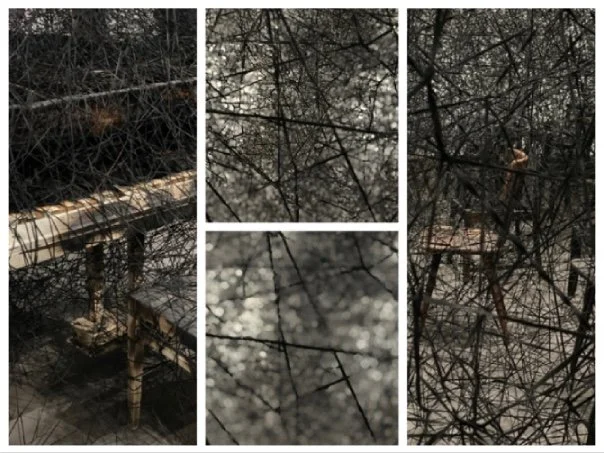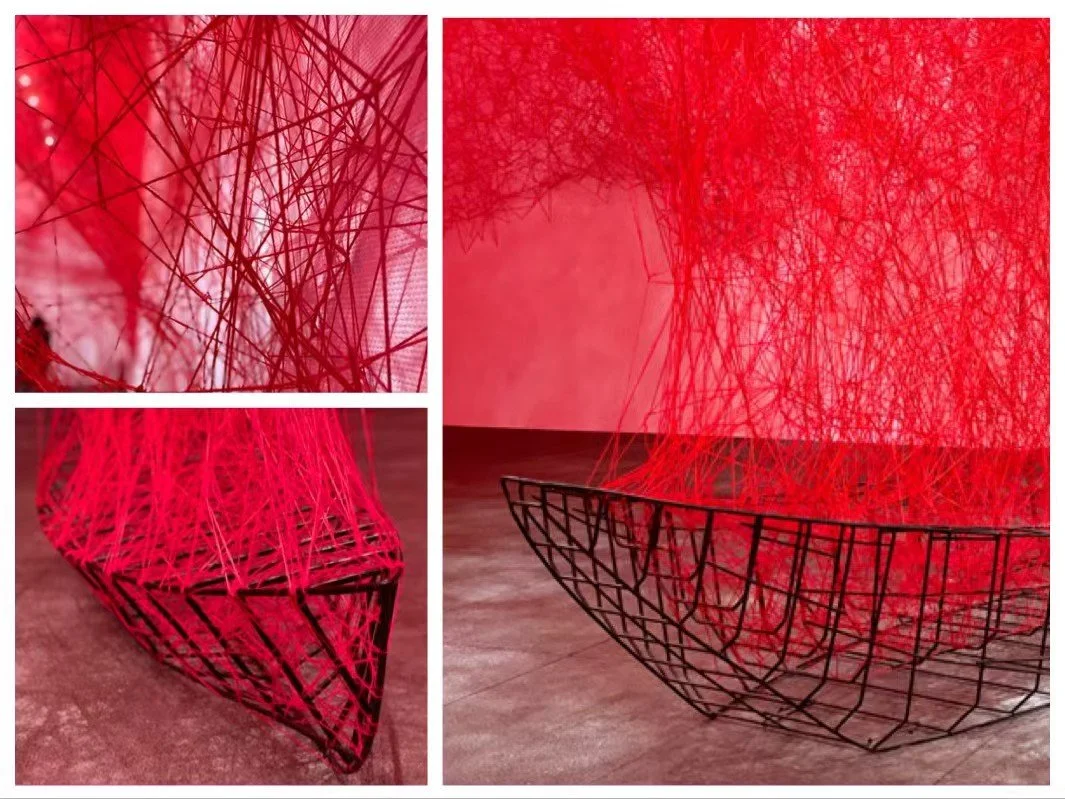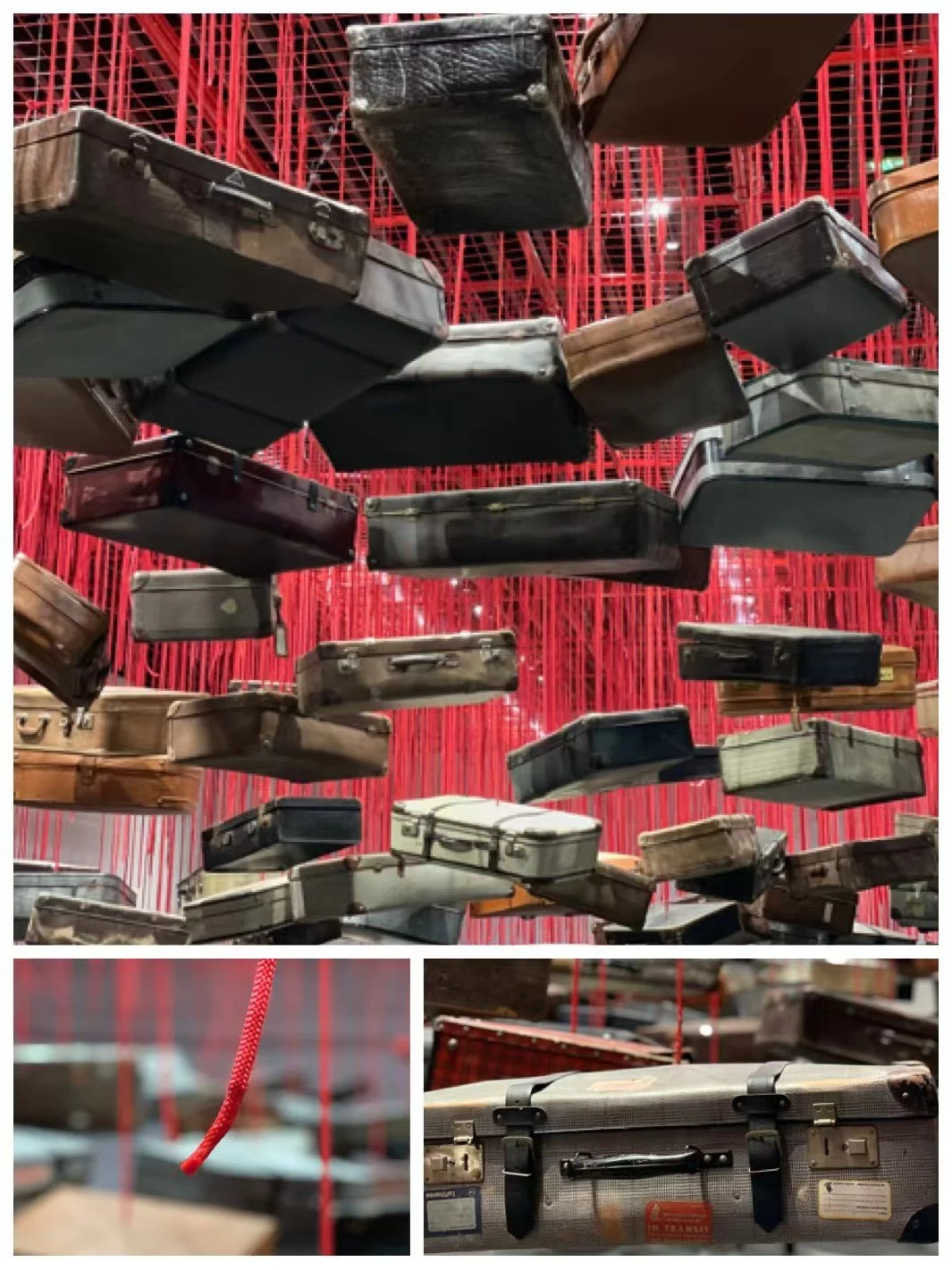That's Mags.com : Talking Arts: Tale-Telling Yarns at Shenzhen Art Museum (by Rachel Wu)
The room is taken over from ceiling to floor by a web weaved in black yarns like dark clouds falling from the sky, consuming energy of any living forms in the room.
The piano and audience chairs are in their usual position, five rows arranged in an oval shape facing the white grand piano.
Each chair is different; they must have been assembled for this particular solo piano performance.
Two chairs at the front row are in small size, obviously for children, the rest are for adults.
The chairs and the piano are all scorched, devasting and deserted.
You could almost breathe the charcoal smoke, hear water dripping somewhere in the room.
Agony and despair fill the air.
In Silence. Photo by Rachel Wu/That’s
This is an installation art In Silence now in the Shenzhen Art Museum opening exhibition series The Soul Trembles by Chiharu Shiota, a Japanese contemporary artist based in Berlin, Germany.
Born in Osaka, Japan in 1972, Chiharu Shiota was determined to be an artist when she was 12.
She received formal art education in Japan and then embarked on her life-long journey studying and working abroad.
She started experimenting on installation art and performance art when she was studying in Germany during the late 1990s and early 21st century, following her mentors Rebecca Horn and Marina Abramovic.
It was around 2005, after years searching for a new method to replace painting that used to carry meaningful purpose for her, Shiota finally found installation art using tangled yarns as her signature voice to articulate her deliberation of life, death and relationship.
In Silence was among her early attempts in installation art.
It derives from Shiota’s experience at the age of 9 when she saw the next-door house burnt down in the middle of the night.
The first version of this installation art dated back in 2002 and then was re-fined in 2008 with by far denser and more complex web structure to create a more compelling impact.
Shiota uses yarns in three colours--black yarns connote cosmos or night, red yarns connote blood or connection between humans, white yarns, which emerged in her recent work in 2017, connote innocence.
Uncertain Journey, created in 2016, depicts a hopeful scene of a densely tangled red-yarn web connecting five small boats composed in black metal frames.
Small as the boats may look, the bare metal structure reveals a sense of resilience sailing in an uncharted terrain.
The warm red web carrying faith, care and kindness will help the boats to get through challenges in this destined journey.
Uncertain Journey. Photo by Rachel Wu/That’s
Shiota has a fond memory of boats as she used to take an overnight ferry to see her grandparents during her childhood.
This happy memory led her to associate boats with red and white yarns, despite her scepticism on where the journey may end.
"A boat is carrying the people and time, so it’s also travelling."
"I feel like we are ready to go, we go somewhere but we don’t know the real destination, where we go exactly. "
"Life is like travelling without destination," she introduced her work in Berlin in 2016.
Shiota first explored symbolic meanings of boats in 2012 in her work Where Are We Going with two rustic wooden boats heading to two opposite directions.
The Key in the Hand, with which she represented Japan in the 56th Venice Biennale in 2015, became a full-fledged immersive installation with 50,000 used mechanic room keys showering the tilted wooden Venician boats heading into an unknown future, red wool yarns project the path of the keys falling from the sky.
The boats, in this artwork, symbolize one’s hand capturing precarious opportunities (as in the image of keys) to usher new horizon.
In 2016 she turned to a more abstract boat image and presented it in a metal frame in her work Uncertain Journey.
This image proliferated in 2017 in both a concrete wooden form or metal skeleton in 6 of her installations, tapping into different ways to represent her introspective narratives on time and purpose of life.
She revisited her previous proposition Where Are We Going in 2017, loosened up the well-structured metal skeleton into one flat frame, allowing white yarns to complete the rest of the boat body.
She then hung the boats high up the ceiling with black yarns at the atrium of Bon Marché Rive Gauche, Paris.
The yarns form a three-dimensional epic painting showing a number of white boats lining up and heading into an unknown cosmos.
Visitors instantly engagedin an adventurous expedition, following the track of the boats while moving up in the elevator.
Shiota’s boat seems far robust in 2017, more confident of a positive end and less concerned of the uncertainty awaited in the journey.
Her contemplation on life and death reveals her transformation from 2008 to 2017:
"Going from life to death is not an extinguishment but a process of dissolving into something vaster.
If this is the case, then there is no longer any need to be afraid of death."
"Both dying and living belong to the same dimension."
It’s a minor pity that the 2017 version of Where Are We Going is not included in the exhibition in Shenzhen.
However, Shiota brings with her Accumulation, Searching for Destination, another classic artwork of hers approaching the theme of destination of life from migrants’ perspective.
Accumulation Searching of Destination. Photo by Rachel Wu/That’s
This art installation presents over 400 suitcases hung by red strings.
You can tell from the buckles that the suitcases belong to a period from 1930s to 1940s.
They are arranged in an S line levelling up from ground to ceiling and yet not all strings have a suitcase attached.
Some are apparently lighter and sway in the air while others are quite stable.
It is fascinating to walk slowly through the room and try to look at the crowd of suitcases in different perspectives.
At one point, they seem to flood into the room with an unstoppable force.
From another angle, they seem like a flock of birds flying to some remote place.
Each suitcase displays distinctive character and carries various marks or scars on them.
You are very much prompted to touch the buckles and feel the leather, attempting to establish some mysterious connection with the individuals who once used the suitcase.
You can’t help but wonder what stories they might hold, do they carry a lamentable romance, a happy reunion or something to be continued?
Drama starts to pop up in your mind weaving imaginative episodes linked to them, just like what Shiota had in hers:
"When I look at a heaping pile of suitcases, "
"All I see is a corresponding number of human lives."
"Why did these people leave the place they were born, "
"in search of some destination? "
"Why did they go on this voyage?"
"I think back on the feelings of these people on the morning of their departure."
Similar to her boat image, the work Accumulation evolved from the 2012 version in which the suitcases were stacked up in a shape of pyramid occupying the corner of the room to the 2014 version when they were hung up in the air.
The new version vividly captures uncertainty of migrants’ lifelong journey and mixed emotions, anxiety in a new place, nostalgic in their visiting countries and dislocated even back in their home country.
All these emotional implications truly resonate with Shiota’s personal experiences.
As the exhibition winds in Accumulation, Searching for Destination, Chiharu Shiota has walked through her unique journey as a contemporary artist, her quest for a meaningful medium that articulate her introspective narratives, questions fundamental to purpose of life and her transformation in the process.
As to what Shiota would expect from her audience, she is interested in their immediate emotional response upon entering the installation space.
She mentioned in her previous exhibition in Shanghai, when she starts a piece of artwork she would think carefully how her audience enter the installation, or how she can create an instant soul-trembling moment for them.
So what is your first impression of Shiota’s work or what exactly is your soul-trembling moment in the exhibition?
Article published on https://www.thatsmags.com




